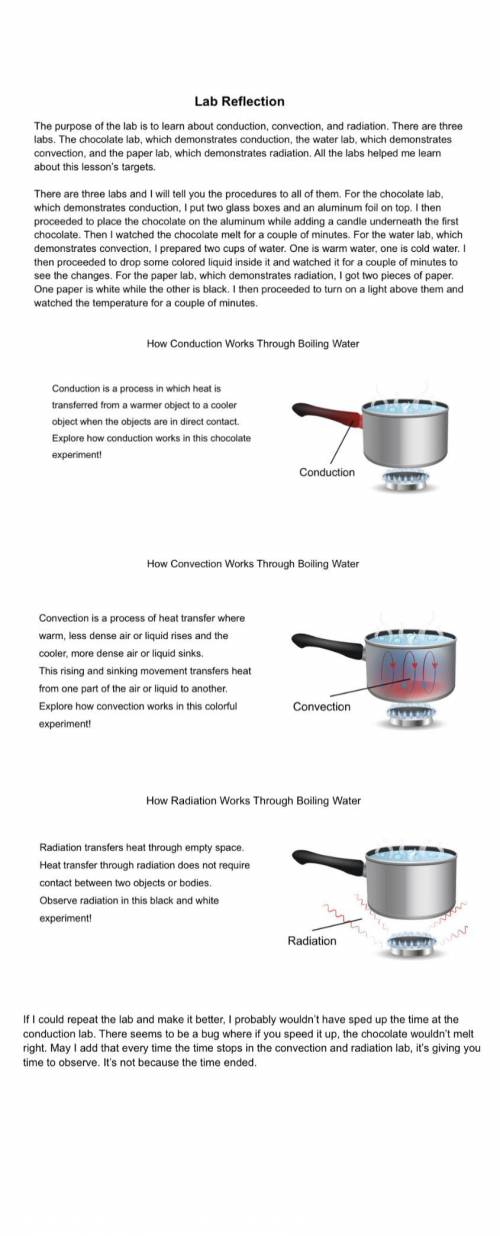
Plate Boundaries and Movement lab report Directions Now that the lab is complete, it is time to write your lab report. The purpose of this guide is to help you write a clear and concise report that summarizes the lab you have just completed. The lab report is composed of two sections: Section I: Overview of Investigation o Provide background information. o Summarize the procedure. Section II: Observations and Conclusions o Include any charts, tables, or drawings required by your teacher. o Include answers to follow-up questions. o Explain how the investigation could be improved. To help you write your lab report, you will first answer the four questions listed below based on the lab that you have just completed. Then you will use the answers to these questions to write the lab report that you will turn in to your teacher. You can upload your completed report with the upload tool in formats such as OpenOffice. org, Microsoft Word, or PDF. Alternatively, your teacher may ask you to turn in a paper copy of your report or use a web-based writing tool. Questions Section I: Overview of Lab 1. What is the purpose of the lab? 2. What procedure did you use to complete the lab? Outline the steps of the procedure in full sentences. Section II: Observations and Conclusions 3. What charts, tables, or drawings would clearly show what you have learned in this lab? Each chart, table, or drawing should have the following items: a. An appropriate title b. Appropriate labels 4. If you could repeat the lab and make it better, what would you do differently and why? There are always ways that labs can be improved. Now that you are a veteran of this lab and have experience with the procedure, offer some advice to the next scientist about what you suggest and why. Your answer should be at least two to three sentences in length. Writing the Lab Report Now you will use your answers from the four questions above to write your lab report. Follow the directions below. Section I: Overview of Lab Use your answers from questions 1 and 2 (above) as the basis for the first section of your lab report. This section provides your reader with background information about why you conducted this lab and how it was completed. It should be one to two paragraphs in length. Section II: Observations and Conclusions Use your answers from questions 3 and 4 (above) as the basis for the second section of your lab report. This section provides your reader with charts, tables, or drawings from the lab. You also need to incorporate your answers to the follow-up questions (from the Student Guide) in your conclusions. Overall When complete, the lab report should be read as a coherent whole. Make sure you connect different pieces with relevant transitions. Review for proper grammar, spelling, punctuation, formatting, and other conventions of organization and good writing.

Answers: 1
Another question on Biology

Biology, 21.06.2019 18:30
Which table best shows the impacts resulting from human activity? impact of human activities human activity impact forest area cleared to construct an airport increase in oxygen level vegetation cleared to construct an oil mine increase in pollution impact of human activities human activity impact forest area cleared to construct an airport increase in sound pollution vegetation cleared to construct a power plant contamination of water impact of human activities human activity impact beehives cleared from urban areas increase in vegetation dams constructed on a river increase in fish population impact of human activities human activity impact beehives cleared from urban areas increase in bird population dams constructed on a river better quality of water
Answers: 3

Biology, 21.06.2019 21:00
Epinephrine is a hormone released from the adrenal gland of the body, most often in a stressful situation. it is known as the "fight-or-flight" hormone. one way that it causes a response in the body is to activate receptors on muscle cells. where are these cellular receptors located? a. on the cell membrane b. in the nucleus c. on the cell wall d. around the mitochondria
Answers: 1

Biology, 21.06.2019 22:00
An easy way to calculate the amount of energy available at each level is to what?
Answers: 3

Biology, 22.06.2019 04:00
Of your good in bio kusing a series of preliminary observations; pstate a problem developed from these observations, formulate a hypothesis, design an experiment to test the hypothesis
Answers: 3
You know the right answer?
Plate Boundaries and Movement lab report Directions Now that the lab is complete, it is time to writ...
Questions







Chemistry, 19.07.2021 01:00




Mathematics, 19.07.2021 01:00

Mathematics, 19.07.2021 01:00


Spanish, 19.07.2021 01:00

Mathematics, 19.07.2021 01:00


Physics, 19.07.2021 01:00


Mathematics, 19.07.2021 01:00




